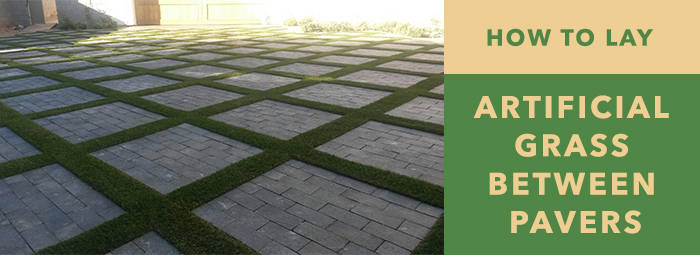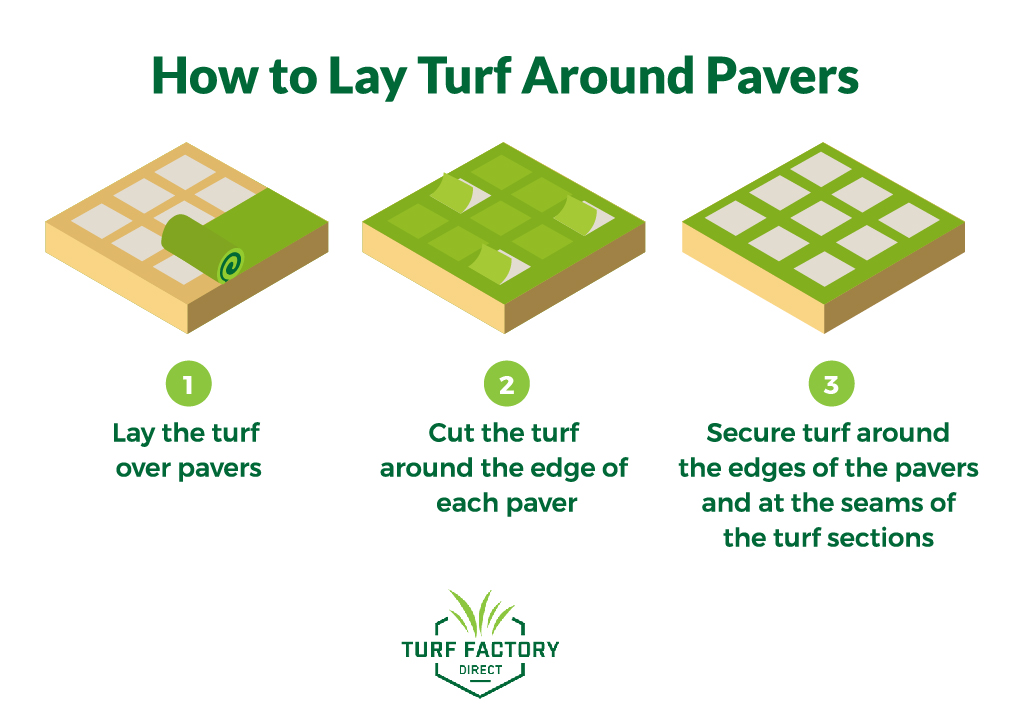
Turf makes it possible to achieve the look of upscale landscaping without the cost of regular maintenance from professional landscapers. Unlike some landscaping projects, laying artificial grass requires little technical skills and expertise. While it can be a big project, it’s completely possible for someone with low levels of experience to install artificial grass without professional assistance.
Not only is it easier, more cost-effective, and less time-consuming than some forms of landscaping, turf has huge water-saving benefits. The big question and focus of this article is this: can you install artificial grass between pavers?
The answer is a resounding yes. It’s totally possible for someone with minimal skills to install artificial grass on their own, though professionals will have the experience to ensure the job is always done right.
How To Install Artificial Grass Strips Between Pavers
Installing turf between hardscapes like pavers is very similar to installing a turf lawn, with a few key differences. In any situation, the hardscape will need to be placed first, and then turf installed around it, whether it’s stones, bricks, or poured concrete. Trying to complete this sort of landscaping in reverse by laying turf first and then the pavers can result in damaged turf and a less attractive result.
First: Get Quality Turf
Turf is great for edging other materials like concrete and stone because it doesn’t become overgrown. Turf remains neat and tidy, making it excellent for framing detailed masonry patterns.
There are different varieties of turf designed for different uses. characteristics based on what they are used for. Many people are probably familiar with putting turf, which has a short, stiff pile that is designed to allow a golf ball to roll on across the surface with minimal resistance, and provide traction for shoes to help keep people from slipping.
Landscaping turf is designed to resemble natural grass, which has a longer pile than putting turf, and the tufts of fibers have multiple shades of green and brown to resemble the variegated coloration in blades of grass. For the purposes of edging pavers, we recommend a landscaping turf with a shorter pile like the 50 Special or the K-9 Supreme. To be certain of the turf you want, get landscaping turf samples or simply ask the experts.
How Much Does Artificial Grass Cost?
Turf alone can typically range from $2-$8 per square foot, depending on the type of turf. Installing a turf lawn can range $4-$20 per square foot including materials and labor. Turf Factory Direct provides high quality turf directly from the manufacturer, guaranteeing the best price.
Surface Prep
Most importantly when installing artificial turf, it’s essential to make sure there is proper drainage. To do so, turf requires a level surface and base of ¾” to ¼” crushed drain rock. When placing the drainage fill, make sure it is of good quality that will allow water penetration. You do not want to use a well-rounded rock like most pea gravels, as they will not compact well.
The elevation of the drainage fill must be no more than 1/2 inch below all hardscape after compaction. This will prevent any trip hazards or toe-stubbing after years of foot traffic. When compacting the drainage fill, use a hand tamper to compact it properly. If the drainage fill is not compacted a majority of the turf ribbons will settle over time. If the surface is not level, water can collect under the turf and cause it to slump or bubble, making it more likely to tear, and you will have to remove and replace and start all over again. When the compaction is complete make sure the drainage fill is dry and tight. This will allow for the proper securing of the turf.
Turf Installation
Place and align sections of turf over the hardscape and allow it to sit for at least an hour. This will allow the turf to settle and conform to the ribbon space.
When the sections are placed make sure that each section’s grain lines up so that there is no difference in alignment. If the turf’s grain is placed in opposite directions, the grass will look disjointed.
Secure the Turf
This is where there is the largest difference between installing a turf lawn and installing turf between pavers.
When installing turf ribbons you’ll need many nails to secure the edge. Normally when installing a turf lawn, you cut the turf before securing it. Since there are a greater number of smaller sections of turf, you must secure the turf before cutting it.
First, secure edges by using 5-inch nails (40d) every 16 inches at all edges, and 5-inch nails (40d) every 12 inches down the center of the ribbon.
Then, place 3 ½ inch (16d common sinkers-framing nails) every 4 inches on the center between the 5 inch (40d) nails placed at the edge of the hardscape. The 16d nail heads are much smaller than the 5-inch nails and will not trap the fibers. Less manipulation and a smaller nail head will hide nail placement.
Cut the Turf
Once all the turf sections are secure, take a sharp knife and make an incision between the artificial grass fibers at the edge of the hardscape.
Follow the edge of the hardscape, cutting the turf along the edge until you reach back to the starting point of cutting.
Remove the middle section and move on to the next area to be cut out.
Once all sections are cut and removed it is time to secure them turf in place at the seams.
Secure the Turf Seams
When all the sections are cut, use seam tape and glue to adhere the sections together. Carefully read and follow all the instructions that come with the products for proper use. Once all the turf ribbons are cut and secured it is time for the infill process.
Infill
Since the area of ribbons is small, it makes practical sense to spread the infill by hand. Using a drop spreader will lessen controllability and will cause the turf fibers to be trapped by placing too much infill so infill slowly and carefully.
Be careful not to lift edges. Excessive brushing and raking can cause the edges to lift and extract the edge nails. Take a stiff hand brush and brush the fibers vertically. If the ribbons are big enough then a power broom may be used.
Getting Creative with Turf
There’s plenty of ways to get creative with artificial grass, like mixing it with natural or artificial grass lawn alternatives, or create an oasis by installing turf on a deck. You can even install turf on the roof of your house! Whether you’re installing artificial grass on your lawn, livening up a shady patio, or creating a mixed landscape using different materials, turf is an excellent choice. Our team is standing by to help you with your artificial turf needs. Get in touch with us to learn more or start your own artificial turf project today.








